Wind Energy
The facts and advantages of wind energy—and why we’re turning to turbines to power our clean energy future.

Turbines at Heritage Sustainable Energy's Stoney Corners Wind Farm in McBain, Michigan
Shutterstock
For thousands of years, humans have recognized the potential of harnessing the wind: propelling ships, pumping water, and even sawing wood. Today, modern wind power and other forms of renewable energy are the fastest-growing energy sources in the world, with wind making up about 10 percent of total energy production in the United States. Read on to learn more about how declining costs and enticing climate, health, and economic benefits are helping wind energy soar.
What is wind energy?
Let’s start with some basics. Wind is the movement of air caused by pressure differences in the earth’s atmosphere, which is caused by the uneven heating of the earth’s surface from the sun. Because of earth’s irregular surface, the slight tilt of the planet, and its rotation, different areas heat up at different rates. As warmer air expands and rises, it creates a pressure imbalance with the nearby cooler air, which then rushes in to fill that space. That’s the wind! The greater the pressure difference, the stronger the wind: like an untied balloon blowing out air.
How does wind energy work?
Generating wind energy is all about kinetic energy, aka the energy of motion. Anything that moves—a person walking, a dog running, a book falling—has kinetic energy. A wind turbine takes the kinetic energy of wind and turns it into electrical energy. (Be careful not to confuse wind turbines with the iconic windmill, which was invented over a thousand years ago and was primarily used to mill grain, not generate electricity.)
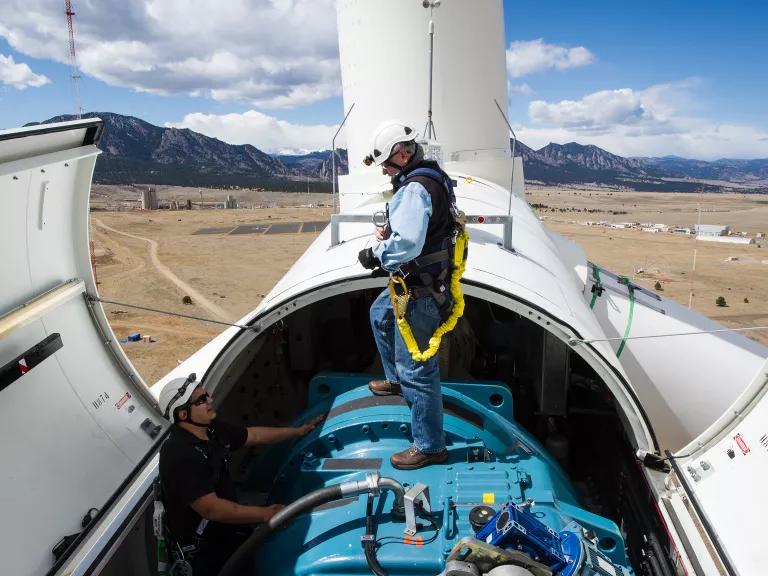
The nacelle of a Siemens 2.3 megawatt wind turbine at NREL's National Wind Technology Center (NWTC) in Colorado
Dennis Schroeder/NREL, 24548
How do wind turbines work?
The most common type of turbine used in the United States today are horizontal-axis wind turbines, which have two to three long, flat propeller blades that face the direction of the wind. Less common are vertical-axis wind turbines, which have blades that look like the beaters in a mixer and don’t have to face the wind to capture energy. This latter type is not as efficient at producing electricity.
Each wind turbine contains a set of propeller blades attached to a rotor at the very top of the turbine tower. Connected to the rotor is a nacelle—a box-like covering that contains a shaft and a generator. The kinetic energy is transformed into electricity by a chain of churning: the wind spins the blades, which also spins the rotor, which then turns the shaft, which spins the generator. The electricity produced by the generator flows down the turbine tower and through a transformer to be converted to the right voltage to be transmitted to our power grid. This entire process produces no air pollution, unlike fossil fuel–powered plants, which have to burn through polluting coal, oil, or gas to create the steam that turns the gears to create electricity.
The bigger the wind turbine, the more energy it can produce. Turbines are also tall because wind blows more consistently and faces less resistance higher up in the air. Longer blades can catch more available wind, even in places that are relatively less windy. There is a wide range in turbine sizes but the average land-based turbine installed in 2022 was 321 feet tall, with propeller blades that are 429 feet in diameter.
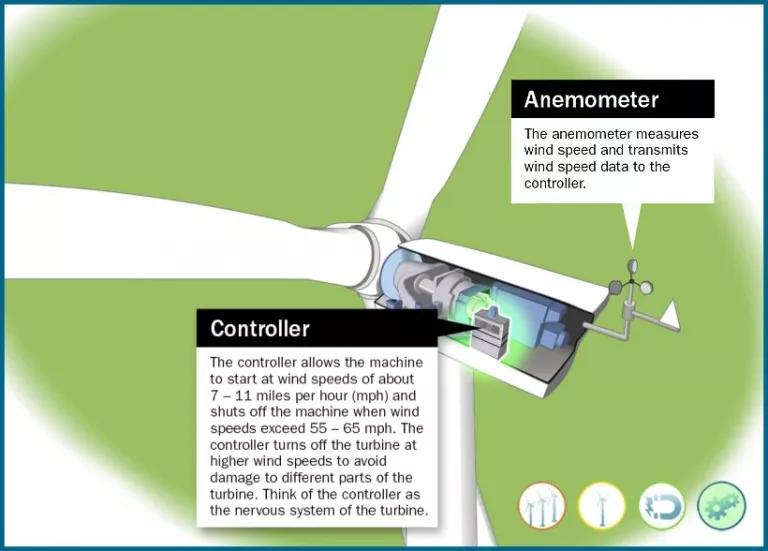
Key wind turbine components, the controller and the anemometer, and their functions.
U.S. Department of Energy
Other key components of a turbine include the anemometer and the controller. The anemometer measures wind speed and sends the data to the controller, which turns the turbine on when the wind has reached the minimum speed of 7–11 miles per hour. The controller turns the turbine off if wind speeds are too high to avoid damaging the blades, around 55 miles per hour.
According to the U.S. Energy Information Administration, the average output of a new commercial wind turbine is 843,000 kilowatt-hours of electricity per month. The average U.S. home uses about 893 kilowatt-hours of electricity a month, so a single commercial wind turbine could power nearly 1,000 homes. (By comparison, to power just one home for a month would take more than 1,000 pounds of coal and 6,600 cubic feet of gas.)
What are wind farms?
Wind farms—essentially, groups of wind turbines—are often located on agricultural lands and in rural areas. Most are owned by independent power producers that sell the electricity to utilities and consumers.
Deciding where to place a wind farm is an essential part of the development process. For starters, a farm should be sited away from large trees and buildings, which might block or slow the wind. Some are built adjacent to communities in remote areas where importing fuel might be expensive. Others are planned in more populated areas with high energy needs. The good news is that wind farms can be developed both on land and over water. There are three key types.
- Land-based wind energy projects: Sometimes referred to as onshore wind, these range in size, with as few as two or three turbines. The average U.S. utility-scale wind farm has 50; the country’s largest (and the third largest in the world) is the Alta Wind Energy Center in California, with 600 turbines. For those located on farmland (as is common in parts of the Midwest), crop rows can be planted and livestock may graze between the turbines, as when landowners choose to host wind developments in exchange for annual payments from power companies.
- Distributed wind energy projects: These are also land-based but operate on a small scale, with capacity that is usually under a megawatt. Instead of generating wholesale energy for a utility, a distributed wind project is on the customer’s side of the meter. It might include just one or a few turbines to serve local needs, like powering a water pump on a farm or electrifying a home.
- Offshore wind farms: Turbines built over water are larger than those on land (up to double the size), allowing them to better catch the strong coastal winds. They can either be anchored onto shallow seafloor, in which case they’re called fixed-bottom wind turbines, or installed on a floating platform in deeper waters. A small floating turbine might power an offshore research facility. A larger farm could supply mainland communities, with the electricity transported via cables to the power grid on land.
Advantages of wind energy
With the clean energy transition comes a windfall of benefits.
Health benefits
Wind energy’s health benefits aren’t about what it produces, but what it doesn’t: air pollution. Long-term investments into clean energy mean we can rely less on power plants that burn coal, oil, and gas, which generate pollutants linked to respiratory and cardiovascular damage, as well as environmental harms. For instance, coal-fired power plants generate 35 percent of mercury emissions in the United States, as well as two-thirds of our sulfur dioxide emissions (which contribute to acid rain) and the vast majority of harmful particulate matter in our air.
Climate benefits
Electricity production accounts for 25 percent of the United States’ greenhouse gas emissions. That’s because we still rely on burning fossil fuels, mostly coal and gas, for 60 percent of the nation’s power supply. As we grapple with the escalating impacts of the climate crisis, we absolutely must end our dependence on fossil fuels by increasing sources of clean energy, like wind.
Cheap energy
Wind energy has rapidly become one of the cheapest energy sources in the country—dropping by 74 percent since 2008 to reach a record low in 2018. (Supply chain issues have recently caused prices to tick up somewhat.) Consumers stand to benefit even more from new investments in the industry. For example, as engineers develop taller towers and bigger blades, turbines can produce power with lower average wind speeds. As efficiency improves and fewer materials are required, operation and installation costs will decrease.
Job creation and economic growth
As the wind industry expands, job opportunities are growing along with it. As of 2022, wind power employs just above 125,000 people, who manufacture, operate, and maintain turbines across the country. According to the U.S. Department of Energy (DOE), there are more than 500 U.S. manufacturing facilities for components, such as blades, towers, and generators. The DOE also estimates there could be up to 600,000 jobs within the wind industry by 2050.
Challenges with wind energy
As bright as the future of wind may be, like with any industry, there are challenges to developing and operating wind projects.
Weather and location dependency
Wind is generated everywhere on earth. It’s abundant and inexhaustible—but also variable and uncontrollable. And we need strong, sustained winds to generate reliable electricity. Weather variability makes it harder for communities, especially in low-wind regions, to depend on wind power for all of their energy needs. In the United States, the areas where wind resources are most plentiful may be far from the biggest energy consumers, like densely populated cities.
One major, overdue solution: Update the U.S. power grid. As the nation takes steps to modernize its grid infrastructure, increasing the capacity of the existing grid, incorporating more distributed energy sources, and building new transmission lines will go a long way toward ushering in the clean energy future we need. In fact, in times of record-breaking heat and electricity demand, new wind energy resources have helped save our grid more than once. And when we can connect wind resources across different regions—to capture wind blowing in one area while it’s slowing down in another—we’ll boost resilience even more.
Another solution is battery storage, which can capture excess energy generated by renewable projects and discharge it when it’s needed. Battery storage can increase flexibility and prevent blackouts, especially when it’s combined with improving wind technology, forecasting, and transmission. It also helps to have other renewable sources like solar—since the sun may be shining when the wind isn’t blowing, and vice versa.

Eagles, trainers, and a veterinarian participated in research to help the U.S. Department of Energy's National Renewable Energy Laboratory develop a radar and visual systems that prevent bird strikes with wind turbines.
Dennis Schroeder/NREL
Wildlife impacts
Many people, including the experts at NRDC, are working to ensure that we develop wind in a way that takes into account the well-being of wildlife and delicate marine ecosystems, which face risks as the industry grows. At the same time, fossil fuels are no friend to wildlife: Tens of millions of animals are killed indirectly each year by fossil fuel projects that destroy habitats, pollute the air, and contaminate water. And climate change, caused largely by the extraction and burning of fossil fuels, will do even more harm.
One of the biggest concerns with wind is the potential risk of birds and bats colliding with propeller blades, especially during migration. Thankfully, efforts are being made to minimize harm. For instance, in February 2024, the U.S. Fish & Wildlife Service released a permitting rule that requires wind projects to be demonstrably low risk to bald and golden eagles. The DOE has also committed to studying potential conflicts between wind and wildlife.
Hazards specific to offshore wind farms might include collision risks with construction and maintenance vessels, as well as disruptive noise during the surveying and construction of a wind farm, which can interfere with the communication between marine mammals. But with proper planning, these impacts can be minimized. NRDC serves on the board of the Renewable Energy Wildlife Institute, which supports research on these solutions, and as far back as 2012, NRDC has collaborated with wind developers to create guidelines that protect marine ecosystems during planning phases. This includes having construction and operations boats move slowly through the water to reduce the risk of whale strikes, monitoring when whales are nearby so loud construction noises don’t disturb them, employing tools that reduce sound impacts, and avoiding construction when whales are feeding or migrating through the area.
Transportation and shipping
As technology evolves and turbine parts get larger, transportation and installation become more challenging. For instance, a port could be equipped for deliveries of large turbine parts, but if the roads out to the designated site are not wide enough, the parts can’t reach their destination. Companies are looking into how to build flexible blades that can be transported more easily and methods to produce the parts right on-site at wind farms.
Aesthetics
A common talking point for wind energy skeptics is that the tall towers are too much of an eyesore, especially against a natural landscape. Despite critics’ best efforts, however, public opinion on wind and solar energy has remained positive, with around 75 percent of U.S. adults in support of expanding wind farms. For the vast majority of people, solving the climate crisis is worth altering the view.
Climate misinformation
There’s a lot of climate misinformation out there, and clean energy doesn’t get a pass. Despite what some social media posts may suggest, turbines do not pose a risk to human health. More than 100 peer-reviewed studies about wind energy have concluded that there are no health harms from things like infrasound (low frequency sounds that cannot be audibly heard), shadow flickers (when the blades pass over the sun and cause a quick flicker), or electromagnetic field emissions.
Wind energy growth in the United States
Most land-based wind farms in operation today are located along the West Coast and across the Great Plains in the Midwest, where developers have found strong, consistent winds. Just five states generated half of the country’s wind power in 2022: Texas, Oklahoma, Iowa, Kansas, and Illinois.
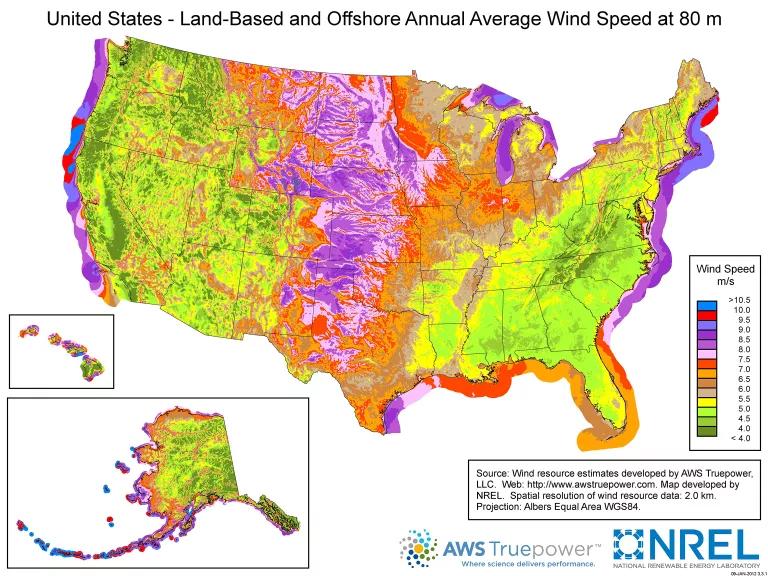
Map of U.S. wind capacity.
NREL/U.S. Department of Energy
Wind energy development is spreading to other parts of the country—both onshore and off—thanks to decreasing costs and the new policies and renewable energy standards that many states are using to combat climate change. Rock Port, Missouri, was the first town in the country to build a community-scale project that has the capacity to generate all of the city’s electricity needs from wind. The project’s four wind turbines are capable of generating 5 megawatts of power—double the amount that the community of 1,200 residents usually needs. When they have excess power, they’re even able to sell it to the state’s power pool.
Some states that once balked at introducing wind farms into their coal-dependent economies have felt the winds shift, if you will, and are now investing in renewable energy projects. (Looking at you, Wyoming.) Unfortunately, high interest rates and supply chain issues have slowed this progress in some places.
Right now, the United States has three completed offshore wind farms: the Block Island farm in Rhode Island’s waters; the Coastal Virginia Offshore Wind pilot project; and the South Fork Wind farm off Long Island, New York, which has the capacity to generate 130 megawatts of energy, enough to power 70,000 homes, with 12 turbines. Many more wind farms are in development, including the 800-megawatt Vineyard Wind 1, which is already generating electricity near Massachusetts. In fact, more than 7 gigawatts of offshore wind projects, supplying power to seven states, are expected to be operational within the next three years.
A much-needed boost for U.S. wind energy came from the Inflation Reduction Act. Government incentives, including tax credits and funding for planning and analysis, have spurred greater private investment. That means more renewable energy, more new jobs, and more action on climate. And that’s a future we’d like to breeze toward.
This NRDC.org story is available for online republication by news media outlets or nonprofits under these conditions: The writer(s) must be credited with a byline; you must note prominently that the story was originally published by NRDC.org and link to the original; the story cannot be edited (beyond simple things such as grammar); you can’t resell the story in any form or grant republishing rights to other outlets; you can’t republish our material wholesale or automatically—you need to select stories individually; you can’t republish the photos or graphics on our site without specific permission; you should drop us a note to let us know when you’ve used one of our stories.
We need climate action to be a top priority in Washington.
Tell President Biden and Congress to slash climate pollution and reduce our dependence on fossil fuels.
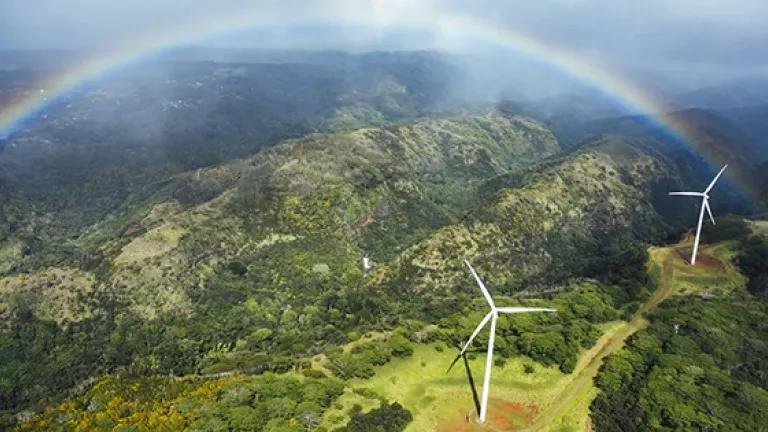
Urge President Biden and Congress to make equitable climate action a top priority
2023 was the hottest year on record, underscoring the urgency of shifting to clean energy and curbing the carbon pollution that is driving the climate crisis. President Biden and Congress have the tools to get the job done.


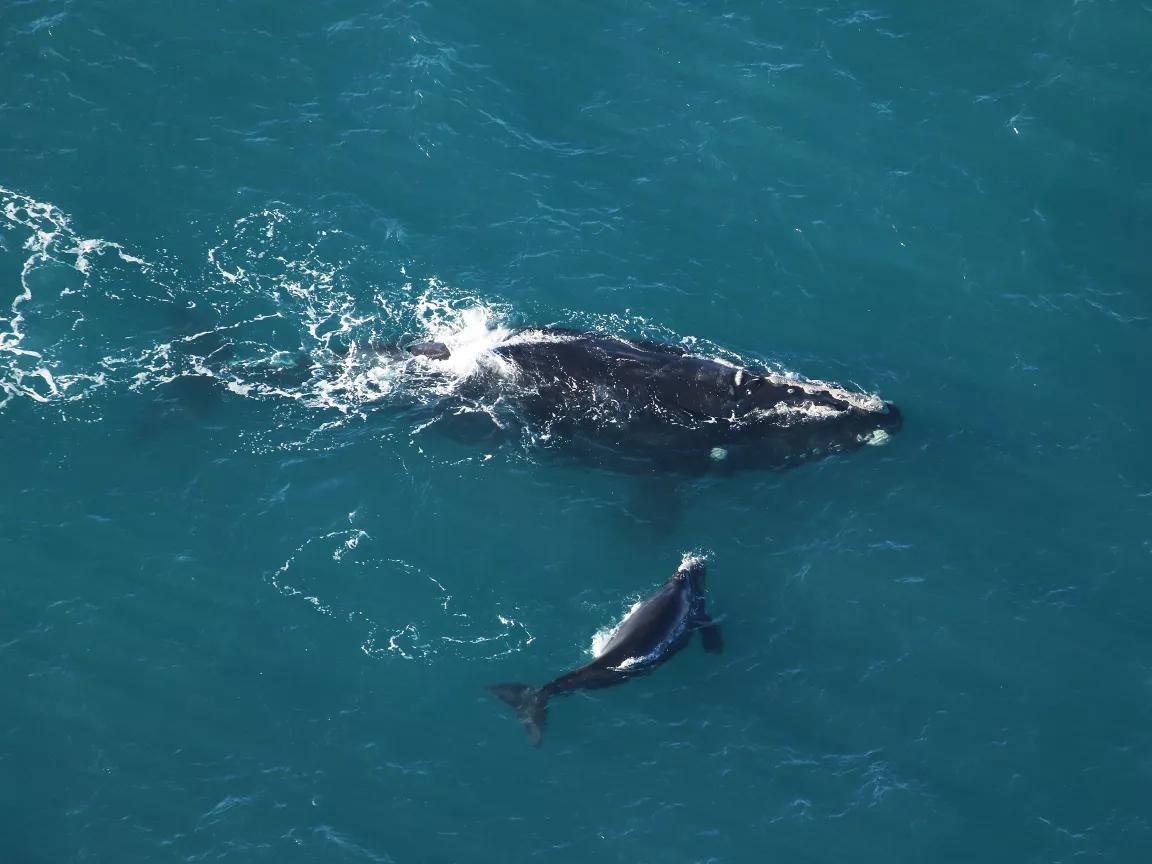
Solar Power 101
A Consumer Guide to the Inflation Reduction Act
The Supreme Court Ends Chevron Deference—What Now?
Solar Power 101
A Consumer Guide to the Inflation Reduction Act
The Supreme Court Ends Chevron Deference—What Now?
Solar Power 101
A Consumer Guide to the Inflation Reduction Act
The Supreme Court Ends Chevron Deference—What Now?
Solar Power 101
A Consumer Guide to the Inflation Reduction Act